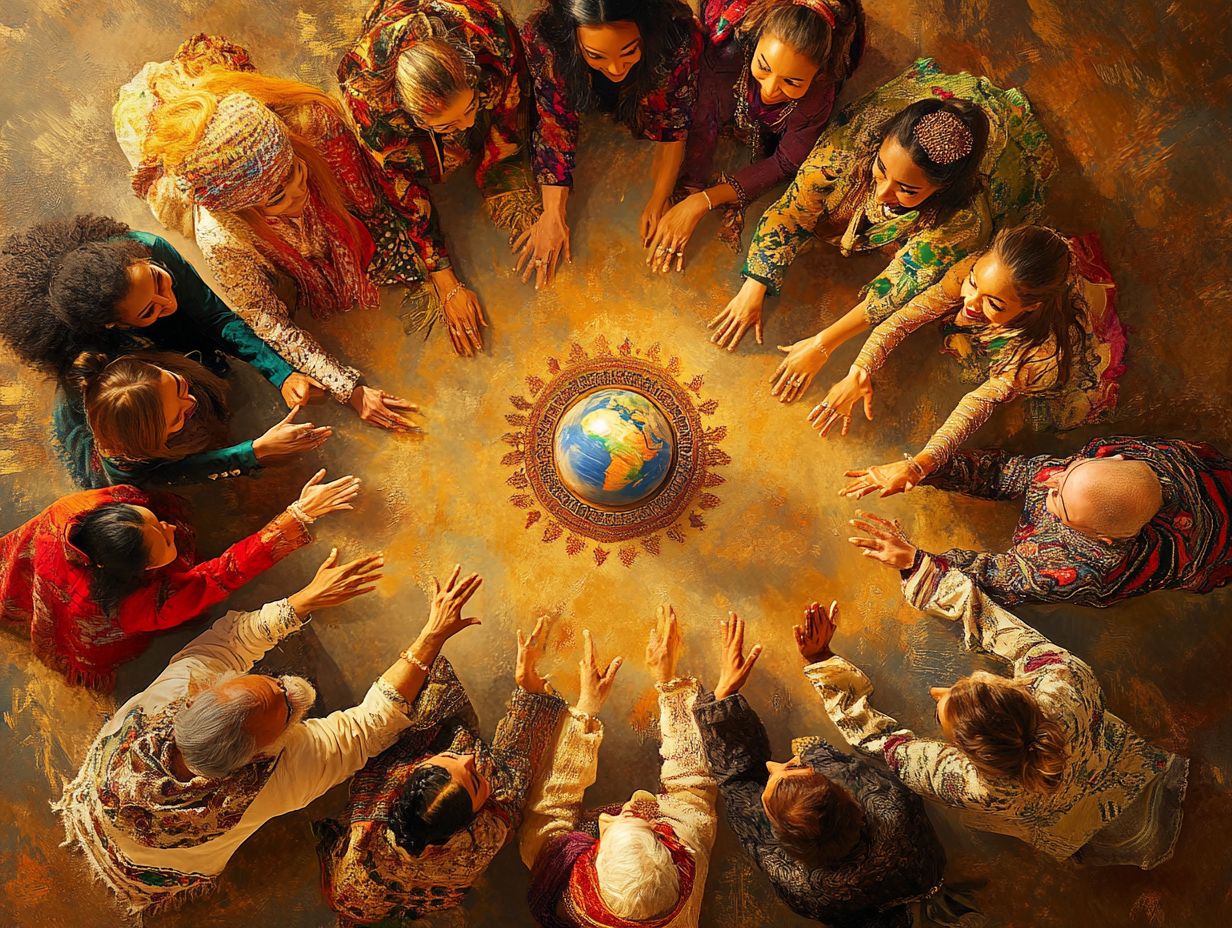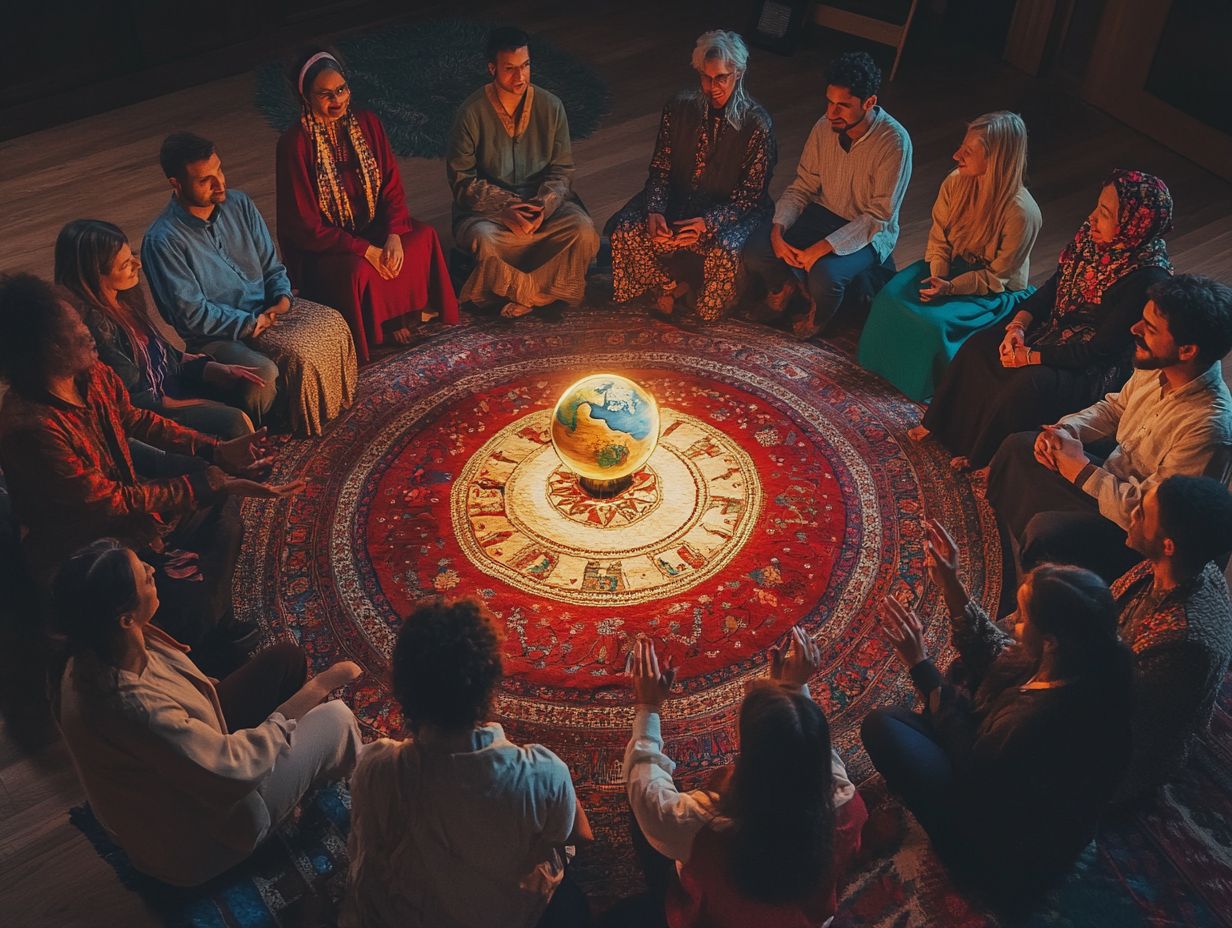Approaching Conflict Resolution in Different Cultures
Conflict is an inevitable aspect of human interaction, yet the way you navigate these disputes can vary dramatically across cultures.
Understanding these cultural differences is essential for effective conflict resolution. This article delves into how culture shapes your approaches to conflict, highlighting key concepts such as direct versus indirect communication and individual versus group orientation.
You will discover effective strategies for resolving conflicts across cultures, identify common pitfalls, and explore how collaboration can foster understanding and compromise.
Join us to discover how to resolve conflicts in our multicultural world!
Contents
- Key Takeaways:
- Understanding Cultural Differences in Conflict
- Common Cultural Approaches to Conflict
- Effective Strategies for Cross-Cultural Conflict Resolution
- Challenges and Pitfalls to Avoid
- Building Bridges and Finding Common Ground
- Frequently Asked Questions
- What is the importance of understanding different cultures when approaching conflict resolution?
- How can cultural differences impact conflict resolution?
- What are some common approaches to conflict resolution in different cultures?
- How can cultural sensitivity be incorporated into conflict resolution?
- What are some potential challenges when approaching conflict resolution in different cultures?
- How can one prepare for conflict resolution in a different culture?
Key Takeaways:

- Understanding and respecting cultural differences enhances conflict resolution.
- Active listening, empathy, and collaboration bridge cultural divides.
- Avoiding misunderstandings and stereotypes is crucial for success.
Understanding Cultural Differences in Conflict
Understanding cultural differences in conflict is essential for fostering effective communication and resolution in your diverse workplace. A solid grasp of how various cultural backgrounds influence conflict management can significantly enhance relationships with coworkers.
By acknowledging these differences, your teams can develop successful strategies that resonate with both individual and collective values, ultimately creating a more productive environment. This exploration also highlights the importance of recognizing identities shaped by individualism the prioritization of personal goals and collectivism the emphasis on group goals which can profoundly impact negotiation and resolution approaches in different contexts, as noted by experts like Faryn Sand and organizations such as CultureWizard and Harvard Business School.
Impact of Culture on Conflict Resolution
Culture profoundly shapes your approach to conflict resolution, influencing how you navigate disputes and negotiations across various contexts.
Take Korea, for example: here, the emphasis on harmony often drives individuals to seek consensus through indirect communication, carefully avoiding confrontation to maintain relationships. In contrast, in countries of the Middle East, the focus shifts to honor and personal connections, which can transform negotiation techniques; in this context, direct dialogue might be seen as a sign of respect.
Meanwhile, in Europe, you’ll encounter a rich tapestry of styles: northern countries like Sweden champion egalitarian discussions, while southern nations like Italy tend to embrace more passionate debate.
These examples show the vital role cultural context plays in shaping effective conflict management strategies. By recognizing and understanding these differences, you can enhance your ability to achieve successful resolutions.
Common Cultural Approaches to Conflict
Common cultural approaches to conflict unveil a rich tapestry of communication styles and resolution methods, each intricately shaped by unique historical and social contexts. By exploring these diverse perspectives, you gain valuable insights into how different societies navigate tensions and foster understanding.
Start implementing these strategies to enhance your conflict resolution skills today!
Direct vs. Indirect Communication
Direct and indirect communication styles are two essential approaches in conflict resolution. Each carries unique implications for understanding and cooperation.
You ll find that direct communication, often characteristic of cultures like the United States, places a premium on clarity and the ability to express your thoughts confidently. In contrast, indirect communication, as exemplified by Japanese culture, values context and nuance. When you adopt a direct approach, you’re likely to express your opinions openly, believing that transparency fosters trust and expedites issue resolution.
Conversely, indirect communicators often use subtle hints or nonverbal cues, prioritizing harmony and relationships over outright confrontation.
These differing styles can easily lead to misunderstandings during conflicts. For instance, a direct statement from you might be perceived as rude by someone from a culture that favors subtlety. To bridge these gaps, cultivating cultural awareness and employing skills that help you really hear and understand others will enable you to navigate conflicts more effectively, ensuring that both perspectives are honored and understood.
Individual vs. Group Orientation

The distinction between individualism and collectivism significantly influences how you navigate conflict and resolution across different cultures.
In individualistic societies, such as the United States, personal goals and self-expression take center stage. This often leads to direct confrontation when conflicts arise, as individuals are inclined to voice their opinions openly during disagreements, seeking resolutions that align with their interests.
On the other hand, in many African cultures that embrace collectivism, the emphasis shifts to harmony and the well-being of the community. Here, individuals prioritize group consensus, utilizing diplomacy and indirect communication to resolve disputes.
Cultural orientation affects how teams work together. If you come from a collectivist background, you might focus on building relationships and fostering collaboration. In contrast, those hailing from individualistic environments are likely to emphasize assertiveness and personal accountability.
Effective Strategies for Cross-Cultural Conflict Resolution
Employing effective strategies for cross-cultural conflict resolution is essential for nurturing cooperation and understanding among diverse teams. This approach not only fosters a harmonious working environment but also enhances the overall productivity and creativity of the group.
Embracing cultural differences can turn conflicts into valuable growth opportunities. By addressing conflicts with sensitivity and respect, you can ultimately lead your team to a more cohesive and innovative team dynamic.
Active Listening and Empathy
Active listening and empathy are essential strategies for you in cross-cultural conflict resolution, enabling you to foster understanding and collaboration among diverse teams.
By prioritizing these skills, you can navigate complex dynamics with greater ease. For instance, when a conflict arises due to differing cultural perspectives on deadlines, an empathetic negotiator like you would take the time to grasp how these cultural backgrounds influence those views. Engaging in active listening allows team members to express their concerns openly, without the fear of being dismissed.
This approach not only clarifies misunderstandings but also cultivates trust and respect among your colleagues, which is vital for ongoing collaboration. By transforming contentious situations into opportunities for constructive dialogue, you can ultimately enhance your team s cohesion and collective problem-solving abilities.
Respecting Cultural Norms and Values
Respecting cultural norms and values is vital for achieving successful conflict resolution. It cultivates an atmosphere of understanding and cooperation.
By acknowledging various perspectives from different cultural backgrounds, you foster a dialogue that addresses the specifics of the conflict. This dialogue honors the underlying values at play.
For example, in many Indigenous cultures, group decision-making is important. Disregarding this can escalate tension. In contrast, cultures that emphasize individualism may require personal concerns to be expressed for resolutions to be reached.
Understanding and integrating these diverse approaches enhances communication effectiveness. This ensures that all parties feel heard and valued.
Ultimately, this paves the way for mutual respect and effective problem-solving.
Challenges and Pitfalls to Avoid
Recognizing the challenges and pitfalls in conflict resolution is essential for fostering understanding across diverse cultures.
By being aware of these obstacles, you can navigate conversations with greater sensitivity and clarity.
Misunderstandings and Stereotypes

Misunderstandings and stereotypes can hinder your ability to resolve conflicts. They often lead to further disputes and damaged relationships.
In the complex realm of cross-cultural interactions, these barriers stem from deeply ingrained beliefs and misinterpretations of behaviors or intentions.
For example, you might see assertiveness as aggression due to your cultural norms. Meanwhile, someone else may view it as necessary engagement.
Such disconnects escalate tension and obscure collaboration opportunities.
To navigate these challenges, adopt active listening techniques, cultivate cultural empathy, and engage in open dialogue.
By actively addressing these discrepancies, you can pave the way for more constructive conversations.
Power Dynamics and Hierarchies
Power dynamics and hierarchies within organizations can complicate conflict resolution. They influence how you communicate and cooperate with your team members.
When perceiving yourself as either subordinate or superior, your willingness to engage can diminish. This may lead to misunderstandings and unresolved conflicts.
For instance, you might hesitate to voice concerns during a meeting with higher-ups. You may fear backlash or dismissal.
This imbalance creates an environment where grievances fester instead of being constructively addressed.
To mitigate these challenges, organizations should establish safe channels for feedback. They should promote a culture of inclusivity and provide training in emotional intelligence (the ability to understand and manage your emotions and those of others) for leaders.
These measures significantly enhance communication and encourage diverse perspectives.
Ultimately, they lead to more effective conflict resolution.
Building Bridges and Finding Common Ground
Building bridges and discovering common ground are essential steps in fostering collaboration and compromise during conflict resolution within diverse teams.
Embracing these practices enhances communication. It cultivates an environment where differing perspectives can harmoniously coexist.
Unlock the power of collaboration!
Collaboration and Compromise
Collaboration and compromise stand as essential pillars of effective conflict resolution, enabling you and your team to navigate differences and reach shared objectives.
When groups from diverse backgrounds unite, they bring unique perspectives that spark innovative solutions. Picture a global project involving teams from the U.S. and Japan. Negotiators discovered common ground by harmonizing American directness with Japanese consensus-building methods, allowing them to address project timeline concerns while honoring cultural subtleties.
Another compelling example is found in international peacekeeping efforts, where nations with a history of conflict come together to foster stability in war-torn regions. By prioritizing dialogue and mutual respect, they demonstrate the power of collaboration.
These examples reinforce the notion that effective cooperation, rooted in understanding and flexibility, leads to successful outcomes even in the most challenging circumstances.
Resolving Conflict Through Cultural Exchange
Resolving conflict through cultural exchange enhances understanding and respect, acting as a bridge connecting diverse perspectives.
When you bring together individuals from various backgrounds to share their unique experiences and traditions, you create an environment where empathy can truly thrive. Picture a vibrant multicultural team engaging in activities like potluck lunches or storytelling sessions. These opportunities allow members to highlight their culinary heritage or personal narratives.
Such interactions can effectively dissolve misconceptions and forge stronger relationships as you learn to appreciate the values of others.
By embracing this approach, organizations not only bolster collaboration but also cultivate an inclusive atmosphere that enables everyone to navigate conflicts with greater ease and understanding.
Frequently Asked Questions

What is the importance of understanding different cultures when approaching conflict resolution?
Understanding different cultures can make all the difference in resolving conflicts. Cultural differences greatly affect how individuals perceive and respond to conflict, promoting effective communication and mutual respect in finding resolutions.
How can cultural differences impact conflict resolution?
Cultural differences, such as communication styles, values, and beliefs, can lead to misunderstandings and make it challenging to find common ground. It is essential to be aware of these differences and adapt accordingly to resolve conflicts effectively.
What are some common approaches to conflict resolution in different cultures?
Common approaches to conflict resolution may include direct versus indirect communication, individualistic versus collective decision-making, and hierarchical versus egalitarian decision-making. Understanding these differences is crucial for adapting your approach.
How can cultural sensitivity be incorporated into conflict resolution?
Cultural sensitivity means being aware and respectful of different backgrounds. You can incorporate it into conflict resolution by actively listening, avoiding assumptions, and being open-minded to different perspectives. It’s also about being willing to compromise and finding solutions that consider the cultural values and beliefs of all parties involved.
What are some potential challenges when approaching conflict resolution in different cultures?
Potential challenges include language barriers, different communication styles, and conflicting cultural values and beliefs. These issues can lead to misunderstandings that complicate finding resolutions. Addressing these challenges is important to effectively resolve conflicts.
How can one prepare for conflict resolution in a different culture?
To prepare for conflict resolution in a different culture, educate yourself about cultural norms, values, and communication styles. Seeking guidance from someone familiar with the culture can also help you approach conflict resolution in a culturally sensitive manner.






